This post may contain affiliate sales links. Please read my disclosure policy.
Having the right frosting consistency can be crucial to the success of your cake or cupcakes. Too thin and your cake and frosting won’t hold together well. Too thick and frosting can be tough to work with. There are a few factors to consider and since questions about frosting consistency are something I get somewhat regularly, I figured it was worthy of it’s own post. So let’s talk about it a bit.
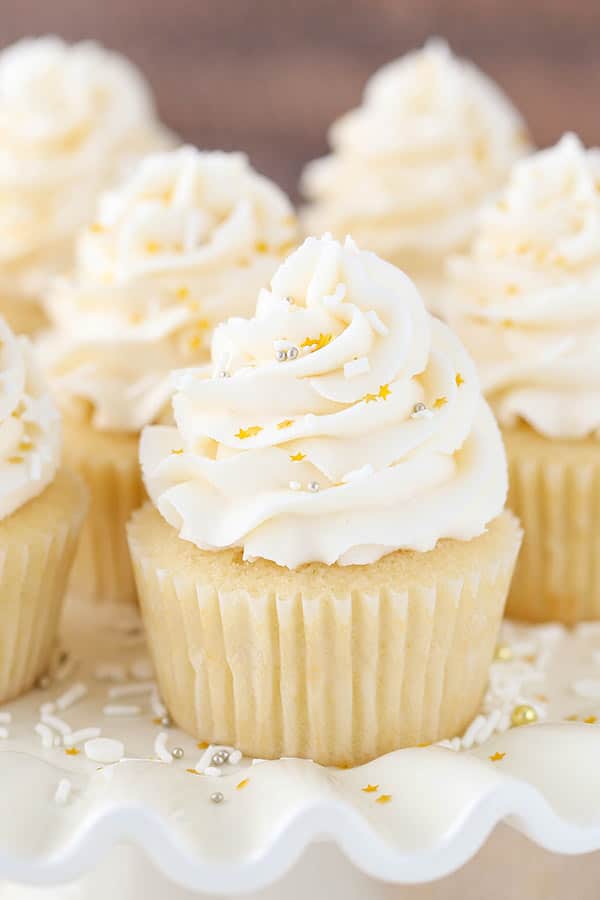
First let’s start with my standard vanilla buttercream frosting (an American-style buttercream) that I use some variation of in a fair number of my recipes. You can click through and read that post for additional information, but as far as consistency is concerned, here’s what to keep in mind:
Butter vs Shortening – I mention in the vanilla buttercream post that I use half and half. You can read all about why in that post, but for consistency sake I’ll mention that shortening is more stable. Using half and half gives the benefit of the butter flavor and the stability of shortening. If you choose to use all butter, keep in mind that it will be softer at room temperature or in warmer temperatures.
Powdered sugar – I often get questions about the amount of powdered sugar used in my frostings. There are two reasons for the amounts usually. One is that powdered sugar is what adds volume to the frosting. You could reduce the amount, but you’d end up with less frosting and therefore need to increase everything overall to have the same volume of frosting I had. Now I’m known to be a little heavy on the frosting because of the way I frost my cakes. If you think you’ll use less frosting, that might not be an issue. The other reason for the amount of powdered sugar I use is the consistency. It thickens the frosting. If you add less than called for, your frosting will end up thinner. Again, because of the way I smooth my cakes when frosting them, a thicker consistency is important. I’ll talk more about that soon.
Liquid – Vanilla frostings will most often use milk, cream or even water as the liquid. The consistency of your frosting is a balance between the powdered sugar (thickener) and liquid (thinner). Certainly the butter plays a part too, but once you’ve got your butter in there, the thickness of the frosting depends largely on the balance of powdered sugar and liquid. With ANY frosting, be careful about adding too much liquid. For example, if you use a strawberry frosting like on these neapolitan cupcakes, you’ll need to consider any other adjustments you make before adding the liquid puree. The amount of puree I add is based on how thick the frosting already is (based on the amount of powdered sugar). Because I add the full four cups of powdered sugar, the frosting is thicker and can hold the recommended 5 tablespoons of puree. If you were to reduce the amount of powdered sugar, you’d also need to reduce the amount of puree. Otherwise you’ll likely have a very soft frosting that doesn’t hold it’s shape or it’s place on your cupcake.
So to review —> the amount of powdered sugar + the amount of liquid = the consistency of frosting.
Ok, so now that we’ve talked about how all the parts of the frosting work together to give us a certain consistency, let’s talk about what kind of consistency you want. This will depend on what you’re using the frosting for.
If you are following my tutorial for frosting a smooth cake with buttercream, you will want a thicker frosting. I will maintain that my ratio of butter to powdered sugar to liquid is best, but you can certainly adjust it. The question I get with my tutorial most often is, “Does the paper towel not stick to the frosting?” Because of the consistency of the frosting, the answer is, “No”. However, if the consistency is off and it’s too thin, it will stick.
So how do you know if your frosting is good to go? The best way I’ve found to test this is simply to tap my finger up against the frosting as I’m alternating mixing the powdered sugar and liquid. I just use the pad of my index finger. If I tap it against the frosting and nothing sticks, it’s too thick still. If my finger is coated in frosting and it’s fairly sticky, it’s too thin (at least for frosting a cake based on my tutorial). You want it to be just sticky enough that some of your finger is covered, but not the whole thing. See the photo below.
Correct consistency for frosting a smooth cake
Frosting is too thick
Now if I’m frosting cupcakes, I will usually go for a frosting that is on the slightly thinner side. I don’t need it to stand to stand up to the paper towel, plus I find that frosting has a nicer piped look when it’s a little thinner. Tap your finger against the frosting and it’s correct if the frosting sticks nicely and is fairly sticky. Do not thin it too much though. You don’t want it too thin.
Consistency for cupcakes or a thinner frosting
The other consistency that’s important to get right is when you are using a dam with a filling in a cake, like with this Pina Colada Layer Cake. The pineapple filling is thinner and would likely squeeze out from between the cake layers once built if you don’t use a dam or the dam frosting isn’t thick enough. You want to be sure it stays in place. For this scenario, I use the same consistency of frosting I use for frosting a smooth cake – when tapping agains the frosting, some should stick to your finger, but not the whole finger. Since you’ll be frosting the cake in the same consistency frosting, that works great.
So that’s how I think about frosting consistency! It’s an important aspect of successfully frosting or decorating a cake or cupcakes. I hope you find this helpful!
As mentioned before, you can find my standard vanilla buttercream recipe here.
What are your tips? Are there questions you have that didn’t get answered? Let me know in the comments!


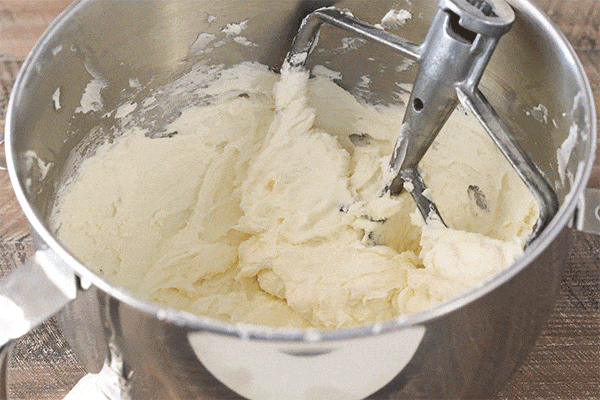
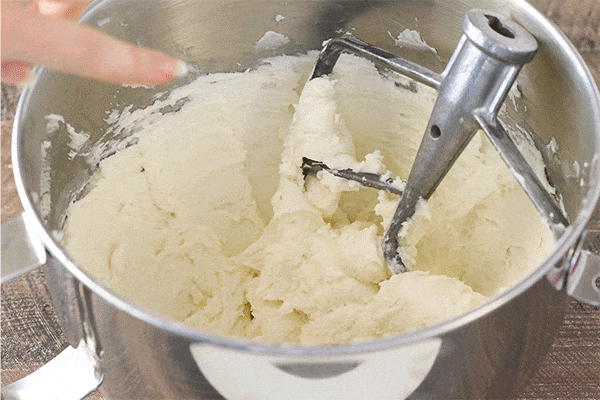
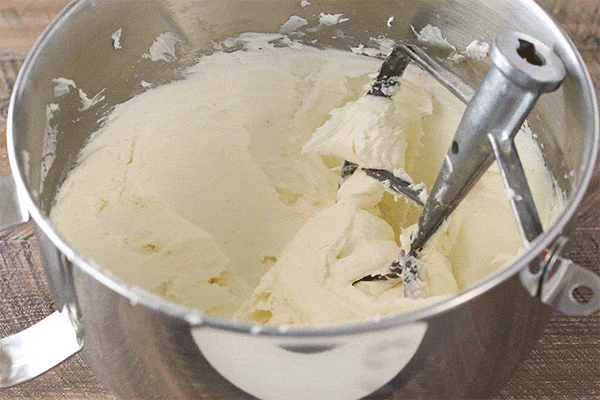
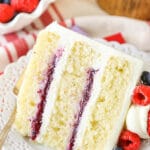
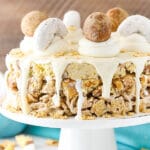

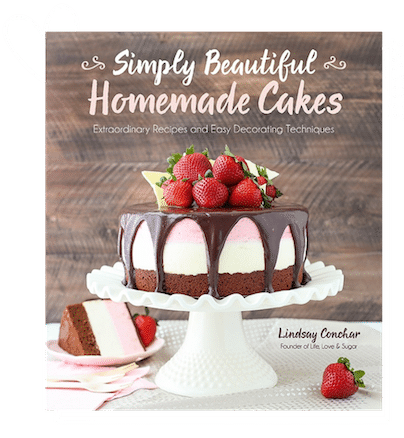
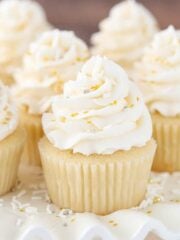
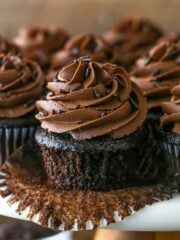

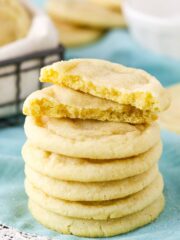
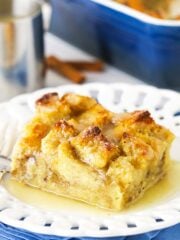
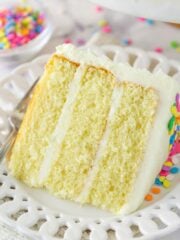
I am so new at this, here is my question I made the buttercream frosting with milk and vegetable
shortening. When I use the piping and tip it doesn’t stand up and hold. I have even place the frosting in the fridge to make the frosting a little stiffer. What am I doing wrong, please help.
It’s hard to say – it could be that you added too much milk or not enough powdered sugar. If it’s too thin though, you could add more powdered sugar to thicken it.
You are my hero! Thank you for the awesome post.
Lol! Thank you! I’m glad you enjoyed the post.
Hi, its Anj and am just wondering what is the best icing should go underneath fondant. Thank u
I really don’t work with fondant a lot, but my understanding is that most people prefer either swiss meringue buttercream or chocolate ganache for something firmer.
Anj, good your ever find a good butterball for under fondes fondant?
Lindsay, I made your Best Moist cake and it was a hit! However, by the end of day, the frosting was sliding off the cake and the piped frosting on cupcakes wasn’t sharp. I plan to make it for my son’s wedding, but covered in fondant and now I’m worried it won’t hold up. Did I do something wrong with the frosting?
It sounds like the frosting was either a little thin or perhaps got to warm. I don’t do a lot of fondant cakes, but back when I did a few of them I actually preferred to use chocolate ganache under fondant because it stayed in place better.
This was very helpful. Thank you so much for the visual of how thick your buttercream should be! I’m a visual person and that was better than even photos!
I’m so glad it was helpful!
Hi. I’m wondering if adding food dye or gel to the frosting would affect the consistency. I need to make a darker blue frosting for a cake so it would require quite a bit of food coloring. Would I need to adjust the amount of sugar to compensate?
Thanks.
If you’re using a gel icing color, it’ll be fine and you don’t need to make adjustments. With a regular food coloring, you might not get the deep color you want without adding a lot of color, in which case you might end up needing to adjust the other liquid ingredients.
I searched very much about this topic. Most articles recommend using heavy cream (Or other creams with high fat percentages). But the fat is not good for me and my husband. How much fat percentage is in this buttercream? Is the heavy cream less or more?
I’ve been making batches of all butter buttercream using unsalted, organic butter. Here in the north eastern part of the US, my kitchen has been pretty chilly, so my butter never seems to get soft enough for me to see it increase in volume after 5 minutes of being beaten in my stand mixer. The butter is left out on my counter overnight.
For the batch I’m making now I just put the bowl with the butter in my oven at 100 degrees for 2 minutes, but it’s too soft now. So, my question is, what temperature should butter be to make the best consistency buttercream.
Thank you!!
I’m not sure what the exact temperature of the butter would be. You want it to be softened though.
Have you tried buttercream with a hi ratio shortening?
I haven’t.
I made some beautiful cupcakes but the next morning my frosting was flatter. It lost some of the fluff in the layers I did. What did I do wrong? It piped beautifully and seemed stiff enough. Suggestions?
Hello!! I’ve tried several of your recipes and I love them as well as you blog!! I’ve tried the buttercream icing you have that calls for reg butter, not salted. I made your milk and cookies layer cake. I’m going to make your moist and fluffy vanilla cake next. But, i cant de ide on which buttercream icing to use with it. Would it matter? What’s the diff in the icing with reg butter and salted? Thank you!!!!
What size cake pans do you use for the Almond Joy cake? I don’t think I found that in the recipe. Thank you.
It’s in #1 of the instructions. I use three 8 inch cake pans. 🙂
this site is the best!!
Glad to hear you enjoy it! Thank you!
Absolutely love this recipe, I’ve used it many times and its delicious. My question is about making it lemon flavoured, would you use an extract or fresh lemon juice, if I used fresh lemon juice would I omit the water? I want to use it as a filling and under fondant, so I don’t really want to put any zest in or I’ll have bits under my fondant.
Yes, replace the water with fresh lemon juice. I would not recommend the extract.
Hi! I know you get asked so much about replacing shortening or people not wanting or able to use it. There is a ‘healthier’ shortening out now using palm oil that is not hydrogenated like regular store brands. I buy it from Amazon it’s Spectrum All-Vegetable Shortening, but the only ingredient is mechanically pressed organic palm oil. You might want to give it a try, but it works great as a sub for regular shortening, has the same stabilizing factor and doesn’t leave that greasy feel you can sometimes get with regular shortening. Just another idea to try if you like! I love your cakes! I’m in a quandary of which of your cakes to pick to make for my next get together!!????
Very useful tutorial for the beginners like me..!!
Pls advise, what can we use instead of shortening ..!!
You can replace shortening with more butter.
Thanks for all the helpful tips!! Quick question – How long do you mix the Buttercream for? Does mixing it longer change the texture by improving it or will it ruin it by over-mixing?
Thanks so much!!
Mixing it longer will really just add air and I often find that an airy buttercream of this type is harder to work with for frosting a smooth cake. If you’re not worried about a smooth cake though, it wouldn’t really matter I don’t think.
can we use icing sugar in the home made chocolate cupcake frosting
Yes, icing sugar and powdered sugar are the same thing.
What a great post!!! I am a good baker and am loving learning about frosting!!! Thanks for all of your insight and handy, dandy tips!!!
I’m so glad you found it helpful! Thanks Edith!